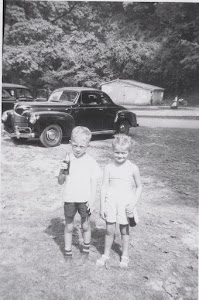 |
| Old Fort site at Mulligan's Bay 2012 |
Ian Macdonald and Mike McMullen follow up on their earlier article about the location of the Hudson's Bay outpost at Chapleau, in which they confirmed that it was located on the Nebskwashi River, commonly known known as the Memegos Property, and not at the Old Fort on Mulligan's Bay. They provide more historical background and make suggestions as to what was at the Old Fort on Mulligan's Bay. Mike McMullen traces his Chapleau connection to 1885 when his great-great uncle Patrick Mulligan arrived, and Ian Macdonald spent most of his growing up years there. Mike and Ian visited Chapleau in May 2013 and also attended the Chapleau High School reunion in 2012. Mike and I are cousins -- our grandmothers May (Mulligan) McMullen and Lil (Mulligan) Morris were sisters.Your comments are most welcome. My email is mj.morris@live.ca
The Old Fort on Mulligan’s Bay
By Ian Macdonald and Mike McMullen
Growing up in Chapleau in the late forties and fifties, we were all aware of the story of the old fort at the Mulligan’s Bay side of the portage to Borden Lake and remember the ruins of the old log cabins. We like most everybody else, simply accepted this as fact and never questioned whether or not such a fort ever existed. It wasn’t until almost a full lifetime has passed that we re-examine this old tale in the context of the actual history of the fur trade in the Chapleau region. It might be prudent to start by taking a step back and viewing this local legend in the broader sweep of history.
The fur trade in Canada was controlled by the Hudson’s Bay Company (HBC) since its formation in 1670 and then with the North West Company (NWC) from the late 18th century until 1821 when, after decades of fierce competition, HBC finally achieved a complete monopoly again by merging with NWC. We do know that during this early period, both HBC and NWC maintained trading posts side by side at Michipicoten on Lake Superior and possibly on or near Kapuskasing Lake at the northern end of both the Kebsquasheshing and Nemegosenda River systems near the present CNR siding at Elsas.
Following the merger in 1821, HBC eliminated half of their inland trading posts including those on Kapuskasing Lake and concentrated their trading activity on the profitable Missinaibi river route. Following construction of the Soo locks in the 1850’s, it became easier to supply the inland trading posts from Michipicoten on Lake Superior rather than James Bay and the original north-south supply route to and from Moose Factory ceased completely in the 1860s. The historic monopoly of the HBC on the fur trade in Canada came to an end in 1870 with the sale of HBC lands (Rupert’s Land) to the Crown referred to as the Deed of Surrender. This marked the beginning of the end of the era of the storied Company of Adventurers and the highly profitable fur trade in the Moose-Missinaibi River Valley.
 |
| HBC store in Chapleau |
We now know for certain that the first recorded presence of the HBC in Chapleau was the construction of a Michipicoten subpost in 1884 (Chapleau Outpost) a mile south of Chapleau on the Nebskwashi River, followed by the opening of a retail store in Chapleau in 1886 managed by Peter Bell.
 |
| Survey crew at HBC outpost |
Peter Warren Bell was a commissioned officer of the HBC and Chief Trader and Factor of the HBC post at Michipicoten from 1865 until 1886 when he became the first Chief Factor of the HBC store in Chapleau. Bell conceived the concept of the outposts at Chapleau, Dog River and Magpie that were built in 1884 to intercept native trade. He remained Chief Factor in charge of the Michipicoten district at Chapleau from 1886 to 1889 until being replaced by Donald McTavish.
 |
| Peter Bell |
There is no evidence to date to support the notion that HBC was ever located on Mulligan’s Bay. We know, for certain, that the site of the old fort on Mulligan’s Bay was crown land from 1870 until 1907 when it was transferred to John Mathew Birmingham of Kingston, Ontario, as a land grant (191 acres). In 1901, an Act to provide for the appropriation of certain lands for the Volunteers who served in South Africa and the Volunteer Militia who served on the frontier in 1866 was passed in Ontario. To be eligible, one had to have been a resident or domiciled in Ontario at the time of enlistment or enrolment for active service. Mr. Birmingham was one who met the criteria. As result of the Act, land grants (usually 160 acres) were available in 27 townships in Northern Ontario, including Cochrane Township in the Sudbury District where Mulligan’s Bay is located.
One is left to speculate, therefore, on the era prior to 1870. Perhaps during the early days of heated competition between HBC and the NWC in the period from 1770 to 1821, one or the other company may have built an outpost in the Chapleau area. Unfortunately, there is no record of such a post anywhere in the HBC archives and many NWC records have been lost. The possibility of a hastily built log building surviving from the early 1800s until the mid-20th century is also very unlikely. A more reasonable argument might be that a cabin(s) was built on the site by an independent trader following the end of the HBC monopoly, sometime between 1870 and 1907.
 |
| Bruce Poynter at Old Fort beach 2012 |
The location was obviously on an established canoe route with an excellent natural beach. Another possibility is that somebody simply built a cabin there as a summering place. The present owner, Bruce Poynter, has discovered many artifacts on the site that suggest that the Mulligan’s Bay site, given a natural beach and location on a major canoe route could well have been an important aboriginal meeting place long before the fur trade era began.



No comments:
Post a Comment